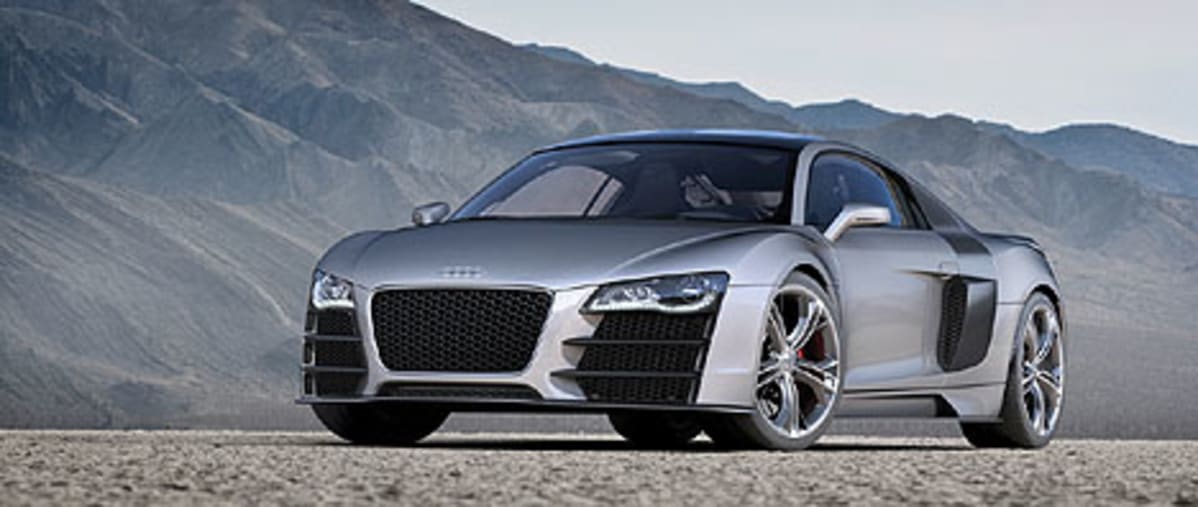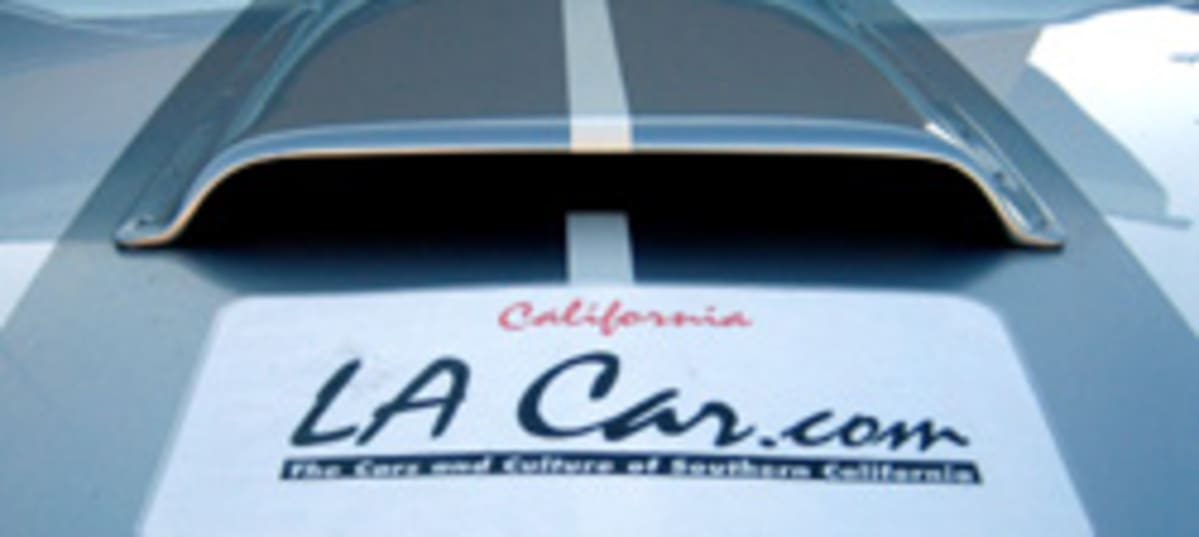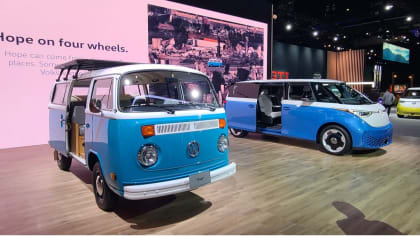BACK SEAT DRIVING - JANUARY 2008
This article is from our archives and has not been updated and integrated with our "new" site yet... Even so, it's still awesome - so keep reading!
Published on Sat, Jan 12, 2008
By: The LACar Editorial Staff


No, this is not the new Volkswagen Routan NAKANO: BACK SEAT DRIVING A ROUTAN BY ANY OTHER NAME? The Latest Oddball Vehicle Name from VW Shakespeare's Juliet said "a rose by any other name would smell as sweet." Perhaps she was correct, since Volkswagen has been coming up with some odd names as of late for its vehicles. And despite the oddity, it seems to have little (negative) impact on sales. The first clue that Volkswagen didn't give a flying finger what anybody thought of its car names was when it decided to rename its popular Rabbit vehicle the Golf. In German, golf is short for golf-strom (English translation: gulf-stream). The fact that "golf" in the USA refers to the sport where you whack a little white ball on a lawn was of little concern to the executives in Wolfsburg (Volkswagen has since returned to the Rabbit name). Then there was the Passat, named after a type of wind. This, of course, led to plenty of jokes about "passing wind." The name has since been accepted into the American automotive lexicon, helped substantially by accolades that the car received from reviewers (particularly the previous-generation Passat). A few years ago, VW lobbed another grenade into the name game with its first SUV (not counting the VW Thing from 1969-1980), the Touareg. The vehicle was named after a nomadic tribe in Africa whose claim to fame included a pre-20th century history of slave trading. Consumers had a hard time pronouncing the name. To this day, its correct pronunciation is in dispute. With its new crossover SUV to be in production this year, Volkswagen took the unusual step of allowing the public to choose its name. The public chose Tiguan, which we're told is a cross between a tiger and an iguana. How did the public come up with such a goofball name? VW had narrowed the choices to the following: Namib, Nanuk, Rockton, Samun...and Tiguan. VW Has Learned Its Lesson. Meet the Routan. At the Chicago Auto Show (February 6 - 17, 2008), Volkswagen will introduce its new minivan - the Routan. "Routan," we're told, is a newly coined word indicating the bond between Volkswagen and America. "Routan" contains both the English word "route" as well as the "-an" suffix which is appended to the names of Volkswagen's European vans - Touran and Sharan. The new minivan is a joint development with Chrysler LLC. The vehicle will be built in the Canadian Chrysler factory in Windsor, Ontario. Both the interior and the exterior will follow Volkswagen's design concept. The appearance, technology and functionality are adapted to the US market. That's why it's called the Routan. Volkswagen is hoping the name Routan will roll off the tongues of every American, just like Touareg and Tiguan. . Your Back Seat Driving comments can be sent to: Letter to the Editor

DAPOZ, MERLO & DAPOZ: BACK SEAT DRIVING You can't understand how big Detroit's annual auto show is unless you're in the Motor City to see it for yourself. It's not that the show itself is big. Sure, it's big, but not notably large on an absolute scale. In terms of space and attendance, the North American International Auto Show is smaller than the auto shows held in Chicago, New York and Los Angeles. But the Detroit show dominates the media and public consciousness of Michigan and beyond like nothing else. From a Los Angeles perspective, think of the Academy Awards, a Lakers' championship, an Angels' championship, a Ducks' championship, the Tournament of Roses Parade, and the Olympics all rolled into one. In Detroit, the auto show is bigger than that. For the show's two-week run every January, the area's two major daily newspapers - the Detroit News and the Detroit Free Press - provide extensive coverage, creating special sections for the show as well as heavy front page reporting, and often devoting the entire front page to the show. Local radio and TV stations provide 'round-the-clock information about and reports from the show. WJR-AM, the top-rated radio station in Detroit, broadcasts daily from the show throughout its two-week run and is known for interviewing auto industry executives, politicians, sports stars and celebrities of all stripes. WDIV-TV, the NBC affiliate, is "the official broadcast partner for the NAIAS" and airs hours of programming on the show - beginning with previews three weeks before the show opens to the public. Local newscasts are anchored from the auto show. Sports is reported from the auto show. Weather forecasts are made from the auto show. The annual Charity Preview, which takes place the night before the show opens to the public, is broadcast live for two hours. Then it's rebroadcast a few hours later. It's impossible to rent a limo or a tux in metro Detroit for the evening unless you've booked months in advance. Presidential hopefuls Mike Huckabee, John McCain and Mitt Romney visited the show on Monday, January 14 - the day before Michigan's Republican primary. They wanted to be seen, and there was no higher-visibility venue in the Great Lakes State. Of course, Michigan's Democratic governor, Jennifer Granholm, was at the show - as well as many other pols. Celebrity chef Wolfgang Puck toured the show, with news release announcing the time and location of his arrival. People drive hundreds miles to attend the Detroit auto show - from not only Michigan but also Ohio, Indiana, Illinois, Ontario and farther a field. Auto enthusiasts fly in to see the show and take vacations to attend. Are these people nuts? Maybe some are. But that's a separate point. The intensity of both media coverage and the public's interest in the Detroit auto show points to passion about cars and the car business. It's not the same in LA or anywhere else. You've got to be there to understand, to feel it, and believe it. There's nothing in the auto industry like it. - Mark Dapoz, Christopher Merlo & Chuck Dapoz For LA Car's coverage of the North American International Auto Show, see Turning Up The Heat In January. Your Back Seat Driving comments can be sent to: Letter to the Editor

Brian Kennedy's new book
NAKANO: BACK SEAT DRIVING
LA CAR'S BRIAN KENNEDY AT VROMAN'S IN PASADENA

Be sure to mark your calendar for Monday, January 28th at 7:00 p.m. That's when LA Car Editor-at-Large Brian Kennedy will be at Vroman's Bookstore in Pasadena to read passages from his new book, Growing Up Hockey. Of course, he'll also be on hand to sign copies and answer questions about his life and times as a sports journalist, automotive journalist and professor of English literature. In Growing Up Hockey, Brian Kennedy explores hockey memories that every fan can relate to, from trading cards in the schoolyard to city league championships. His passion for hockey, fueled by his grandmother, has continued with Brian all the way to the locker rooms of the National Hockey League. Growing Up Hockey has earned accolades from Paul White of Suite101.com, Kat Stein of HockeyBuzz.com, and five star-ratings by the readers of Chapters.Indigo,ca and Amazon.com. When he's not writing car reviews, book reviews or covering auto sports events for LA Car, Brian writes about the Los Angeles Kings and the Anaheim Ducks for Inside Hockey magazine. Date & Time: Monday, January 28, 2008 7:00 PM Location: Vroman's Bookstore 695 E. Colorado Blvd Pasadena, CA 91101 Telephone: 626-449-5320 For map, click here Title of Event: Brian Kennedy discusses and signs Growing Up Hockey
Your Back Seat Driving comments can be sent to: Letter to the Editor

BACK SEAT DRIVING
AUDI INTRODUCES AN R8 V12 TDI
Audi presented the first 12-cylinder diesel engine in a high-performance
roadgoing sports car at this month's North American International Auto Show in
Detroit. The V12 TDI with a displacement of six liters powers a concept car
based on the Audi R8. This unit generates a huge 500 hp and 1,000 Newton-meters
(737.56 lb-ft) of torque.
The manufacturer says the V12 TDI is closely related to the engine in the Audi
R10, the two-time Le Mans winner. It sprints from zero to 100 km/h (62.14 mph)
in just 4.2 seconds and its top speed is well over 300 km/h (186.41 mph). The
peak torque, reached at only 1,750 rpm, paves the way for effortless
acceleration that is unrivaled even at this level.
The new V12 TDI belongs to Audi's family of V engines but has the ideal included
angle for this engine type of 60 degrees between cylinder banks. Its highlights
include the new chain drive layout that includes the two newly developed
high-pressure pumps for the common rail injection system.
Audi has also been writing a new chapter in its success story on the racetrack
since 2006. The diesel engine in the R10 sports prototype won its very first
endurance race at Sebring, Florida, when it was pitted against an entire field
of gasoline-engined challengers. But its most crucial victories were surely in
2006 and 2007 in the 24 Hours of Le Mans, when it simply outclassed the
international elite.
The V12 TDI race engine in the R10 produces over 650 hp from a displacement of
5.5 liters, giving it the potential for a top speed as high as 330 km/h (205.05
mph) depending on the gear ratios. Its power and sturdiness immediately
impressed both fans and experts, who were impressed by its restrained noise
level. Unusual for a race engine, this powerful Audi diesel makes barely more
than a whisper.
Long traditions of motor racing and production technology complement each other
at Audi. The FSI engine of the R10's predecessor, the R8, captured five wins at
Le Mans with a direct gasoline injection system. Audi is also looking to
maximize the advantage by using the race-tested FSI principle in its production
models. The latest examples of this are the V8 with high-revving concept in the
RS 4 and the production version of the Audi R8.

The Drivetrain
The roadgoing version of the new V12 TDI is built at the Györ plant, in Hungary.
And the R8 V12 TDI still has a massive 500 hp on tap. In developing the
six-liter engine, it was a clear priority to integrate it into the current
family of Audi V engines, of which many thousands of versions with 6, 8 and 10
cylinders have already been built - both gasoline and TDI.
Audi's engineers were in a position to use their experience building the racing
engine to develop the road version. Like the other power units in this range,
the distance between cylinder bore axes on the V12 TDI is 90 mm (3.54 in.). Yet
its included angle is 60 degrees, not 90 degrees. This means no free inertial
forces or mass moments of inertia can occur with the V12. The results are
refined in every respect.
The 83.0 mm (3.27 in.) bore and 91.4 mm (3.60 in.) stroke produce a total
displacement of 5,934 cc - just like the 3.0 TDI. At only 684 mm (26.93 in.)
long, this large diesel engine is very compact and just 166 mm (6.54 in.) longer
than the V8 TDI. This compact length is key to accommodating the V12 in the mid-engined
Audi R8.
The V12 TDI crankcase is made from gray cast iron with vermicular graphite - a
high-tech material referred to as GJV-450 that is already used on the V6 and V8
TDI engines. GJV-450, made by a patented casting process, is about 40 percent
more rigid and 100 percent more fatigue-resistant than gray cast iron. This
enabled the developers to make its walls thinner, cutting its weight by around
15 percent compared with conventional gray cast iron.
The two cylinder heads are each made from three main elements. These are a base
section made from a high-strength aluminum alloy incorporating the intake and
exhaust ports, an oil-bearing upper section, and a reinforcing ladder frame
supporting the two camshafts.
The valves are actuated by low-friction roller cam followers; the compression
ratio is 16.0:1. Map-controlled swirl variation of the combustion air has been
adopted from the V6 and V8 TDI engines. This produces permanently optimized
swirl concerning both emissions and high performance.

Injection Technology
As is the case in the Audi V engines, the no-maintenance chain drive is mounted
at the back of the engine, where it occupies little space. Its layout has
changed on the new V12 TDI. The camshafts' sprocket engages in an intermediate
gear via which two Simplex chains drive the camshafts. Two more chains drive the
oil pump and the two high-pressure pumps actuate the common rail injection
system.
The two new dual-piston high-pressure pumps form part of the common rail
injection system supplied by specialty manufacturer Bosch. The two pumps build
up a pressure of up to 2,000 bar in the rails. The piezo injectors with
eight-hole nozzles have also been fundamentally revised.
The high pressure distributes the mixture optimally throughout the combustion
chamber. The result is that the ignition process is faster, more homogeneous and
more acoustically refined. The more efficient combustion process also increases
power output, cuts consumption and reduces pollutant emissions.
The current generation of so-called inline injectors makes effective use of the
piezo effect: piezo crystals expand in a fraction of a millisecond when an
electrical voltage is applied. The number of injection processes per operating
cycle can be varied across a wide range thanks to piezo technology - reaching as
many as five fuel injection operations in the case of the V12 TDI.
As well as the main injection, pilot and post injections are possible. Pilot
injections tone down the acoustic harshness of the combustion process. Retarded
post injections are designed specifically to increase the temperature of the
exhaust gas, promoting regeneration of the two standard particulate filters.
The two turbochargers are located on the outside of the engine's V, each of them
supplying one bank of cylinders. Thanks to their variable turbine geometry, the
full flow of exhaust gas always passes through the turbine, so the chargers
respond slickly - even at low engine speeds - and operate very efficiently.
The two turbochargers, which generate up to 2.6 bar of boost pressure, play a
crucial role in producing the huge torque of 1,000 Nm (737.56 lb-ft) that the
V12 TDI maintains from 1,750 rpm to 3,000 rpm. In developing 368 kW (500 hp),
the diesel achieves a specific output of 62.0 kW (84.3 hp) per liter
displacement.

Two large intercoolers reduce the temperature of the compressed air. The V12 has a twin-pipe exhaust system with two particulate filters. The intake system is similar in structure with one air cleaner per cylinder bank, with an airflow meter behind it. Two control units, sharing the workload in a master/slave principle, manage events in the engine. The Audi R8 V12 TDI concept already fulfills the Euro 6 emissions standard that is likely to take effect in 2014 and calls for sharply reduced nitrogen oxides. By also designing in ultra-precise fuel metering by the common rail system, Audi's engineers have made full use of current clean diesel technology. The heart of the system is a special catalytic converter downstream of the oxidizing catalyst and the particulate filter. The second component in the system is an additional tank containing an aqueous urea solution. Small quantities of the solution, known as "AdBlue," are injected into the exhaust system. The hot exhaust gases break the solution down to form ammonia that splits the nitric oxides into nitrogen and water. The system remains effective for the entire service life of the vehicle. The dynamic character of a sports car depends not just on its performance and torque; the transmission ratios have to be right too. In keeping with the character of a high-performance sports car with unbeatable torque potential, the transmission in the R8 V12 TDI has six manually operated gears. The manual transmission is very compact in design. Together with the small-diameter double-plate clutch, this means it can be installed low down. The manual transmission has very short shift travel and utterly precise guiding of the shifter into the open gear lever gate. It is made from polished aluminum, has an agreeable feel and exquisite sports car looks. Such a high-performance Audi also has quattro permanent all-wheel drive. In the case of this mid-engine sports car, power is distributed variably between the front and rear wheels from a starting ratio of 40:60 to optimize the handling. At this point, the R8 V12 TDI remains a concept car. Audi is mum on whether it will reach production. Your Back Seat Driving comments can be sent to: Letter to the Editor

BACK SEAT DRIVING
Explorer To Get A Much-Needed Extreme Makeover
"Customers are smart. They value vehicles - the more efficient, the better"
said Jim Farley, Ford group vice president of Marketing and Communications.
"Ford gets it.

Technologies and engineering innovations help Explorer America concept deliver
an approximately 20 to 30 percent fuel-economy improvement, depending on engine
selection, while providing room for six and their gear as well as moderate
towing and off-roading capabilities.

This smarter utility concept simplifies Ford Motor Company's systems approach for delivering sustainable vehicles, specifically demonstrating:
- A powertrain lineup that includes a 4-cylinder 2-liter engine with EcoBoost technology delivering 275 hp and 280 lb.-ft. of torque or, as a premium engine, a 3.5-liter V-6 delivering about 340 hp. Depending on engine selection, fuel-efficiency will improve by 20 to 30 percent versus today's V-6 Explorer
- Migration from current body-on-frame to unibody construction, reducing weight and delivering superior driving dynamics
- A fuel-efficient 6-speed transmission with auto shift control, allowing the driver to select and hold a lower gear with just the turn of a dial when conditions warrant it
- A weight reduction of 150 pounds for the V-6 version thanks to its downsized - yet superior performing - engine, as well as more lightweight materials, suspension and chassis components
- Fuel-saving electric power assisted steering (EPAS) and other engine actions that deliver a fuel savings benefit of about 5 percent. Between 80 to 90 percent of Ford, Lincoln and Mercury vehicles will have EPAS by 2012
In addition to its fuel-efficient powertrain and technologies, the Explorer
America concept addresses how the SUV market has changed in the past 15 years.
In the 1990s, customers were drawn by SUVs aligned with people's adventurous,
more rugged lifestyles. Today's consumers are more discerning, demanding
products that are capable and flexible - but more intelligently executed.

The Explorer America concept looks the part, too, with a modern, muscular design
language that belies its ability to harness today's active lifestyles. Its
integrated three-bar grille, defined power dome hood, wrap-around rear glass
panel window and sliding rear door give the appearance that this concept is
ready for modern Lewis-and-Clark types to explore, from their own neighborhoods
to the trail head.
Inside, intelligent features abound, including: single-touch stackable, sliding
seats that allow for convenient access to the second row; a work table with
seats deploy from the tailgate; and a three-dimensional compass and navigation
unit with a topographical map built right into the instrument panel.

Your Back Seat Driving comments can be sent to: Letter to the Editor
A
JOURNAL OF LOS ANGELES & ITS CAR CULTURE That
was LA Car's subtitle when it started back in 1997. It's original website
address was about five times the size of lacar.com. Since then, La Car
became LA Car. Its subtitle became Reporting From Car Culture Ground Zero,
then From The Heart of Car Culture, to today's The Cars and Culture of Southern
California. At all times, however, we aimed to chronicle the Southland's automotive spirit
- much like one's own journal or diary.
LA Car has always been a great source to come back to from week-to-week,
to see what articles and reviews have been added to our rather staggering database.
With Back Seat Driving, a.k.a. BSD (note the similarity to two well-worn abbreviations,
BS and BFD) and Live Wires - Hot & Tender News From the Car Culture
(co-located with Back Seat Driving, and updated at least daily), we
give you some reasons to come back more often (all opinions, by the way, are those
of the respective author).
So, go ahead and bookmark www.lacar.com. We'll be
sure to always provide a link to Live Wires and the latest Back Seat
Driving blog entry. In the meantime, welcome to the journal and journey from
the heart of the car culture. - Roy Nakano For past Blog entries, click the following:
December 2007
November 2007
October 2007
September 2007
August 2007
July 2007
June 2007
May 2007
April 2007
March 2007
February 2007
January 2007
December 2006
November 2006
October 2006
September 2006
August 2006
July 2006
June 2006
May 2006
April 2006
March 2006
February 2006
January 2006
December 2005
November 2005
October 2005
September 2005
August 2005
July 2005
June 2005
May 2005
April 2005
March 2005
February 2005
January 2005
December 2004
November 2004
October 2004
September 2004
August 2004
July 2004
June 2004
May 2004
April 2004




